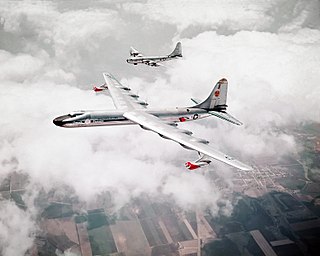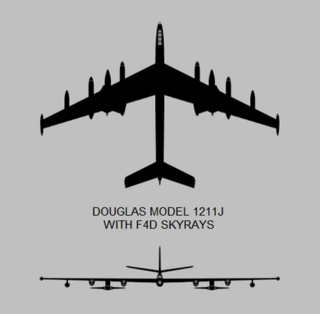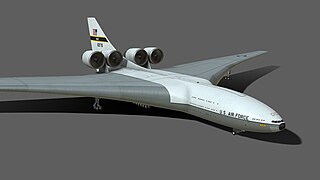This article needs additional citations for verification .(August 2022) |
Below is a list of nuclear powered aircraft and concepts:
This article needs additional citations for verification .(August 2022) |
Below is a list of nuclear powered aircraft and concepts:

The Avro Blue Steel was a British air-launched, rocket-propelled nuclear armed standoff missile, built to arm the V bomber force. It allowed the bomber to launch the missile against its target while still outside the range of surface-to-air missiles (SAMs). The missile proceeded to the target at speeds up to Mach 3, and would trigger within 100 m of the pre-defined target point.

Northrop Corporation was an American aircraft manufacturer from its formation in 1939 until its 1994 merger with Grumman to form Northrop Grumman. The company is known for its development of the flying wing design, most successfully the B-2 Spirit stealth bomber.
The Tupolev Tu-125 was an unrealized project to develop a new long-range supersonic bomber for the Soviet Air Force. Development commenced in 1958 to replace the newest Tu-22. The "Tu-125" designation was an internal one used by the Tupolev design bureau. Since the aircraft was never built, it never received a military designation.

The Heinkel He 343 was a quadjet bomber project designed by the German aircraft manufacturer Ernst Heinkel Flugzeugwerke during the final years of the Second World War. It was intended to perform aerial reconnaissance and fighter-bomber operations in addition to its use as a fast bomber.

A nuclear-powered aircraft is a concept for an aircraft intended to be powered by nuclear energy. The intention was to produce a jet engine that would heat compressed air with heat from fission, instead of heat from burning fuel. During the Cold War, the United States and Soviet Union researched nuclear-powered bomber aircraft, the greater endurance of which could enhance nuclear deterrence, but neither country created any such operational aircraft.
The Martin XB-68 was a supersonic medium tactical bomber with a crew of two that was proposed in 1954 to the United States Air Force. The project, however, was canceled before any aircraft were built.

The Convair XB-53 was a proposed jet-powered medium bomber aircraft, designed by Convair for the United States Army Air Forces. With a radical tailless, forward-swept wing design, the aircraft appeared futuristic; however, the project was canceled before either of the two prototypes were completed.

The Tupolev Tu-95LAL experimental aircraft which flew from 1961 to 1965 was a modified Tupolev Tu-95 Soviet bomber aircraft, analogous to the United States' earlier Convair NB-36H. It was intended to see whether a nuclear reactor could be used to power an aircraft, primarily testing airborne operation of a reactor and shielding for components and crew. The reactor did not actually power the aircraft.

The WS-125 was an American super-long-range strategic bomber project during the Cold War to develop a nuclear-powered aircraft.

The Royal Aircraft Establishment Larynx was an early British pilotless aircraft, to be used as a guided anti-ship weapon. Started in September 1925, it was an early cruise missile guided by an autopilot.
The Myasishchev M-60 was a Soviet design for a nuclear-powered bomber. The design was similar to the M-50 bomber prototype.
The Kuznetsov NK-14A was an onboard nuclear-powered engine which was made to be used on the Tupolev Tu-119 nuclear-powered aircraft, designed and built by the Soviet Kuznetsov Design Bureau. The design of the plane was based on a modified Tupolev Tu-95 and would be fitted with two Kuznetsov NK-14A nuclear-fuelled engines inboard fed with heat from a fuselage mounted reactor and two Kerosene-fed Kuznetsov NK-12 turboprops outboard.

The Vought/General Dynamics Model 1600 series was a fighter aircraft proposal for the United States Navy's Navy Air Combat Fighter (NACF) program. The Model 1600 was a carrier-based derivative of the General Dynamics F-16 Fighting Falcon, but lost to the Northrop/McDonnell Douglas F/A-18 Hornet.

The Hawker P.1103 was a design by Hawker Aircraft to meet the British Operational Requirement F.155; it did not progress further than the drawing board.

The Convair NB-36H was an experimental aircraft that carried a nuclear reactor to test its protective radiation shielding for the crew, but did not use it to power the aircraft. Nicknamed "The Crusader", it was created for the Aircraft Nuclear Propulsion program, to show the feasibility of a nuclear-powered bomber. Its development ended with the cancellation of the ANP program.

The Douglas 1211-J was a bomber aircraft design developed by American aircraft manufacturer Douglas to compete with the Boeing B-52 design for a major United States Air Force contract between 1946 and 1954. The Model 1211-J design was 160 feet long with a wingspan of 227 feet, and was powered by four turboprop engines. The aircraft was designed around a new 43,000-pound conventional bomb but could carry nuclear weapons as well. It could also carry its own fighter escorts, as parasites under its wings. These fighters' jet engines were to be powered up to assist the carrier bomber during takeoff; refueling of the fighters was to take place while they were stowed on the mothership's underwing pylons.

The Lockheed CL-1201 was a design study by Lockheed for a giant 6,000 ton nuclear-powered transport aircraft in the late 1960s. One envisioned use of the concept was as an airborne aircraft carrier.
The General Dynamics Model 100 was a 1960s proposal for a counter-insurgency (COIN) ground attack aircraft intended for use by the United States Air Force (USAF).

The Gotha Go P.60 was a jet-powered flying wing fighter proposed during World War II by Gothaer Waggonfabrik (Gotha). It was conceived as an improved derivative of the single-seat Horten Ho 229, which Gotha had begun to manufacture as the Go 229. The initial concept a two-seat multi-role fighter that was subsequently developed into a three-seat night and all-weather fighter, but no variant was ever built.
The Convair Model 23 was a 1950s design for an American nuclear-powered seaplane for the United States Navy. Like the Air Force's WS-125, the Model 23 never left the drawing board due to risks posed by operations of nuclear-powered aircraft.